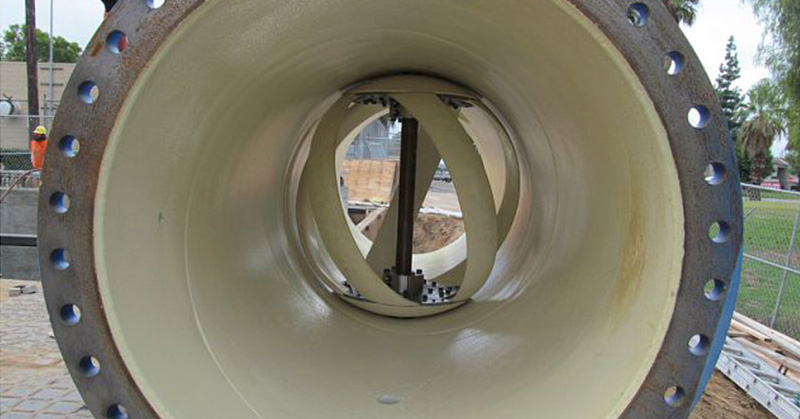Clean water and power are both necessities, and this ingenious company found a way to provide both at once.
The LucidPipe Power System was incorporated into Portland, Oregon, in 2014, and it creates electricity through the water flowing through the city’s pipes. This is a way to get the benefits of hydropower without any environmental detriments, like infrastructures like a dam would create. Small turbines were placed in the pipes to harness the energy from fast-flowing water.
How Do Lucid Energy Pipes Work?
According to the company, this technology can generate 1,100 MWh of electricity every year, about the amount of power needed for 150 homes. It uses the flow of water to spin four 42” turbines to create electricity without disrupting the function of the pipelines or the quality of water. This system was placed in the PWB pipeline under the street at SE 147th Avenue and Powell Boulevard, for those familiar with Portland geography, and produces power for the grid. [1]
Unfortunately, this system can’t power an entire city, but they can generate enough energy for one building like a library or school. They can also help lower the city’s overall energy costs. Water power does not depend on the weather like wind energy, or the time-of-day like solar power, which makes it able to create electricity at any time.
“It’s pretty rare to find a new source of energy where there’s no environmental impact,” says Gregg Semler, CEO of Lucid Energy, the Portland-based startup that designed this power system. “But this is inside a pipe, so no fish or endangered species are impacted. That’s what’s exciting.”
Water utilities require a mass amount of energy to run and this system holds the potential to provide cheaper clean drinking water to those who can purchase it.
Read: Kenya Installs the First Solar Plant That Transforms Ocean Water Into Drinking Water
The First Lucid System
“We have a project in Riverside, California, where they’re using it to power streetlights at night,” Semler explains. “During the day, when electricity prices are high, they can use it to offset some of their operating costs.”
Riverside’s system was installed in 2010 and has gone through several kinds of turbines. The first produced over 20-megawatt hours of energy to the grid. After the pilot’s success, Riverside Public Utilities voted for a permanent system, which was awarded the 2011 Outstanding Energy Management Award by the American Water Works Association, the California-Nevada division.
When they installed a four-turbine system in December 2014 in Portland, the company Lucid Energy has been winning awards for their technological achievements between the two city’s projects. [2]
The Limitations of the Lucid System
However, these pipes do have their limitations. For example, they only work where water is flowing naturally according to gravity. Also, water infrastructure hasn’t developed much in recent years, so mishaps like a pipe burst can be disastrous. One such event occured near UCLA in 2014 and wasted about 20 million gallons of water during a Californian drought.
“They didn’t really know that the pipe burst until somebody from UCLA called,” Semler says. “Our pipe can get indicators like pressure, a leading indicator for whether a pipe is leaking or not. So before it bursts and before we waste all the water, there are onboard information systems that water agencies can get to more precisely manage their infrastructure.” [3]
Perhaps the largest limitation on this technology is the cost. These pipe turbines, like any energy-harnessing infrastructure, require a top coin. It’s a large capital investment. Portland’s water is publicly owned with citizens against higher bills. The $1.7 million project was paid for by private investors Harbourton Alternative Energy, who sell about $2 million worth of power to privately-owned PGE. After 20 years, the Portland Water Bureau will be able to buy the system and own its electricity. [4]
Read: Four Solar-Powered River Barges Are Cleaning Up The World’s Most Polluted Rivers
The Future of Lucid Energy
In 2016, the Portland Water Bureau Conduit 3 Hydroelectric Project received an Excellence in Engineering Award from the Pacific Northwest Section of the American Water Works Association. This celebrated the success of the project to create good drinking water and save money in utilities, plus the technological innovation of the design
Lucid Energy’s goal is to install this new system as old pipelines deteriorate and need to be replaced anyway, which would be much more cost-effective for cities interested in the project. [5]
“There’s a lot of energy in going into making sure we have safe clean drinking water,” says Semler. “Our focus is really on helping water become more sustainable.”
Keep Reading: Desert Farm Grows 17,000 Tons of Food without Soil, Pesticides, Fossil Fuels or Groundwater
- Lucid Energy. FAQ/Fast Facts. https://nwhanew.memberclicks.net/assets/pdx%20ygh%20-%20lucidenergypdxfactsheet-2.pdf
- Purdue ECT Team. Lucid Pipe Power System. Purdue University. https://docs.lib.purdue.edu/cgi/viewcontent.cgi?article=1224&=&context=ectfs&=&sei-redir=1&referer=https%253A%252F%252Fwww.google.com%252Furl%253Fq%253Dhttps%253A%252F%252Fdocs.lib.purdue.edu%252Fcgi%252Fviewcontent.cgi%253Farticle%25253D1224%252526context%25253Dectfs%2526sa%253DD%2526ust%253D1582562351105000%2526usg%253DAFQjCNE6-zZdTgRivnMLs66Eolf9aVX85g#search=%22https%3A%2F%2Fdocs.lib.purdue.edu%2Fcgi%2Fviewcontent.cgi%3Farticle%3D1224%26context%3Dectfs%22 December 8, 2016
- Adele Peters. Portland’s New Pipes Harvest Power From Drinking Water. Fast Company. https://www.fastcompany.com/3041300/portlands-new-pipes-harvest-power-from-drinking-water January 23, 2015
- Terry Slavin. From Oregon to Johannesburg, micro-hydro offers solution to drought hit cities The Guardian. https://www.theguardian.com/sustainable-business/2015/sep/18/portland-oregon-drought-microhydro-electricity-from-water-pipes-lucid-energy-california September 18, 2018
- Portland Water Bureau. Conduit 3 Hydroelectric Project Receives Excellence Award. The City of Portland. https://www.portlandoregon.gov/water/article/584694 July 22, 2016

